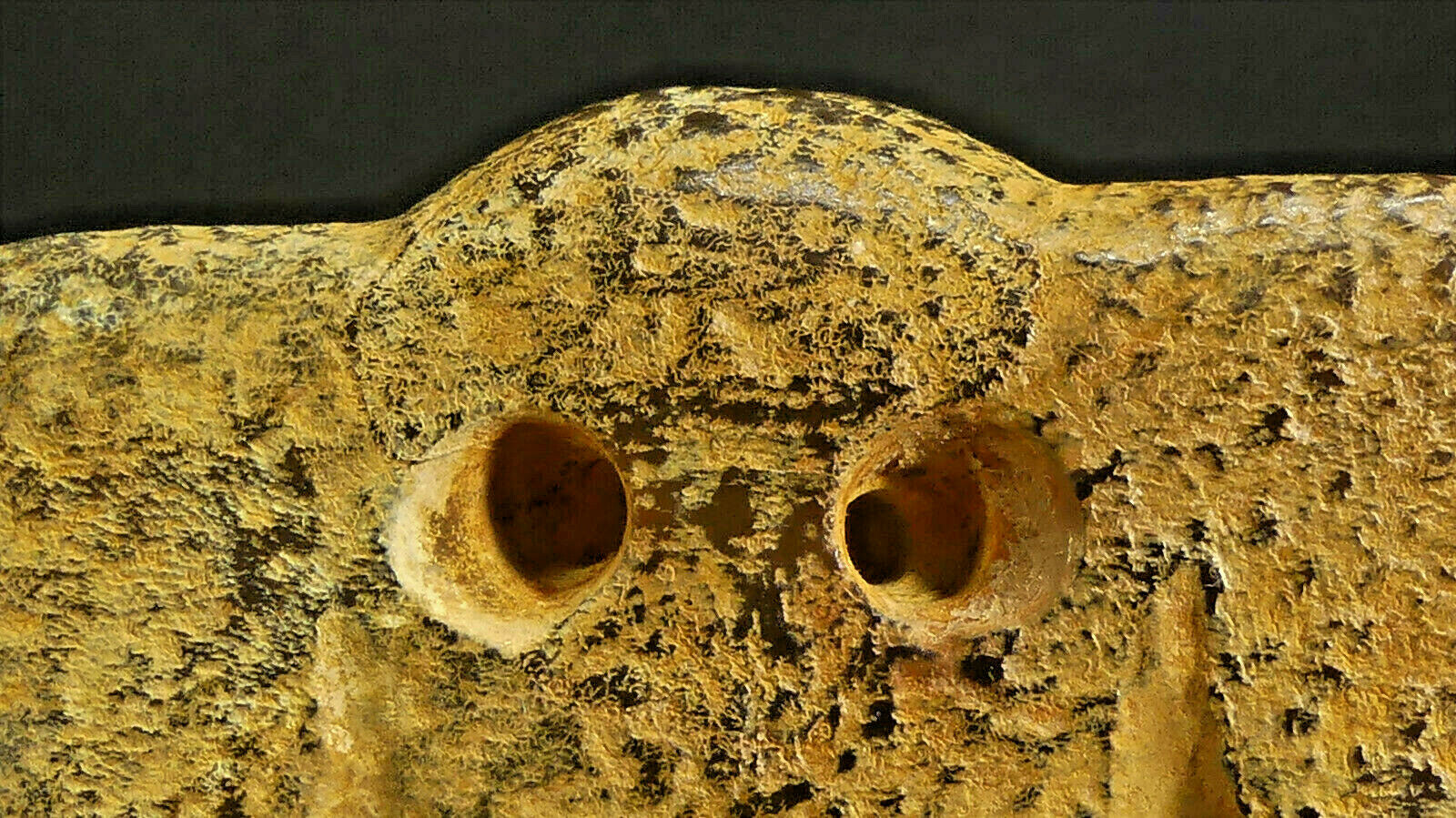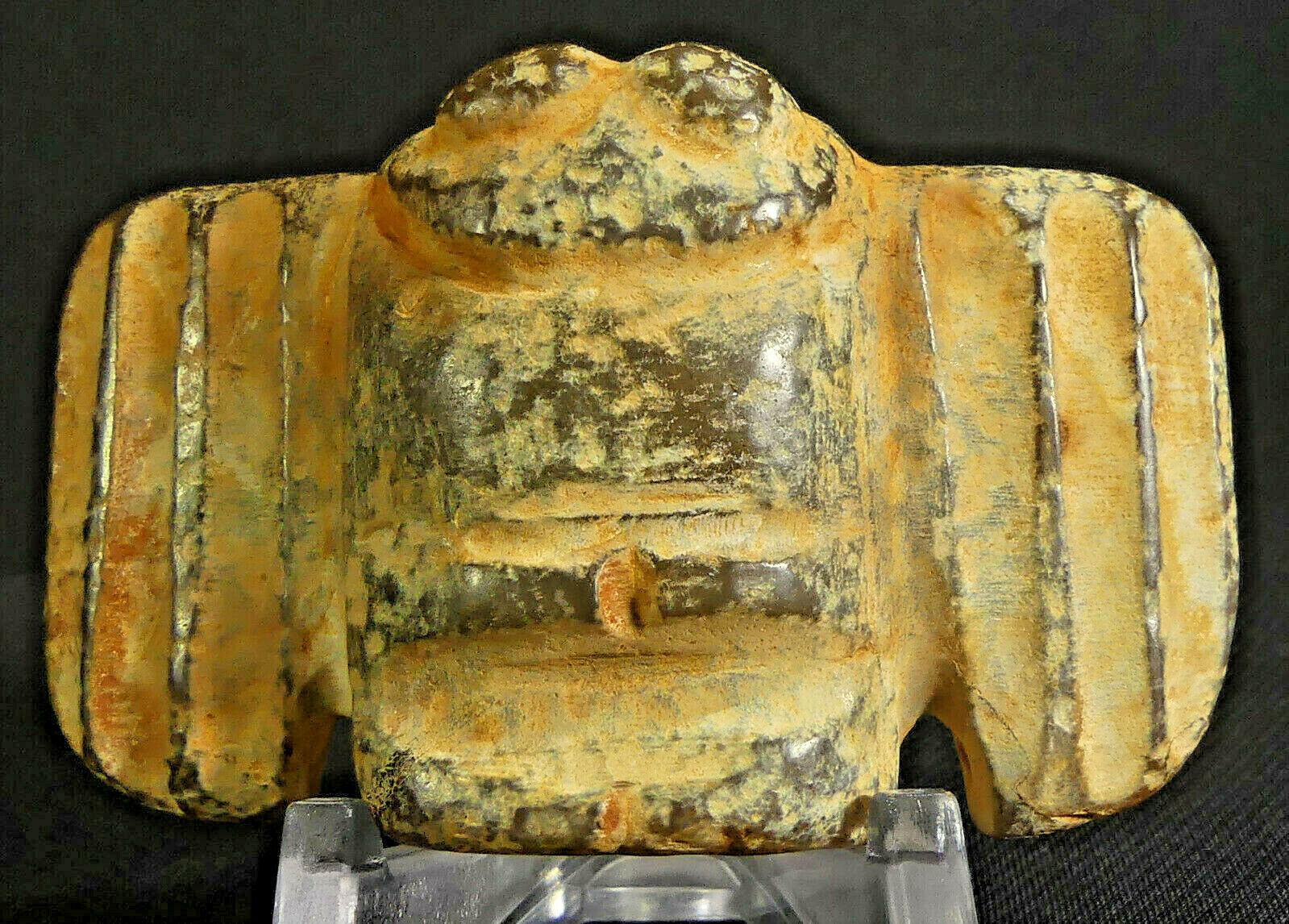-40%
Chinese Hongshan Jade Immortality Falcon Amulet! 80+ Characters w/Translation
$ 1557.6
- Description
- Size Guide
Description
ANCIENT CIVILIZATIONSArtifacts, Antiques & Fine Collect
i
bles
Ancient Chinese Hongshan Culture Jade Falcon Amulet
Nephrite Jade “Messenger of Heaven” or “Heaven Bird”
English Translation of Chinese Characters
English Translation Provided
c.
4500 BC—2250 BC
A gentleman always carried a jade pendant, as a symbol of class and to remind him the virtues of a gentleman,
since those virtues were found in jade
.
—Confucius
This remarkable Jade Falcon Amulet is made of Nephrite Jade and Chinese experts estimate it dates to the Late Hongshan Culture of ancient China (4700—2250 BC) or about 4,500 years ago!
This Jade Falcon Amulet measures approximately 2.27” (58 mm) wide x 1.42” (36 mm) tall x .70” (18 mm) thick and weighs 1.7 oz. (48 gr.) of pure Nephrite Jade!
This lovely amulet contains as many as 80-100 tiny, ancient, Chinese pictographic characters that have been pecked and engraved into the jade on literally every square millimeter of all sides of the amulet—front, back, top, bottom, even on the surface of the Falcon’s two eyes!
This jade amulet has the
most
characters I have ever seen on a single jade amulet!
The large number of characters make this jade amulet unique and Extremely Rare and museum quality!!
{See below for details.}
The Jade Falcon’s beak, large eyes, and extended wings seems to indicate it was modeled after a falcon.
Specifically, my research indicates that this statue is likely based on the Amur Falcon, which was also known as the Eastern Red-Footed Falcon until recently.
The Amur Falcon breeds in Northern China in the same area as the Hongshan Culture lived and the falcons migrate in the winter to Southern Africa.
Ancient Chinese records from the Heian Dynasty in China indicate that falcons were presented as royal gifts in 2205 BC.
Some historians estimate that since about 8,000 years ago, the earliest civilizations in Northern China believed that birds were “Messenger from Heaven” that was sent by the Gods to fetch departed souls that were destined for immortality.
Chinese mythological and religious beliefs thought that a person’s soul, once freed from its Earthly body, traveled to Heaven in the form of a Heaven Bird.
The Amur Falcon’s winter migration pattern to South Africa would have made it appear to the ancient Chinese that the Falcons had left Earth and returned to the Heavens.
The Falcons immortality was reaffirmed when they appeared back in China in the Spring.
The Hongshan Culture
The Hongshan were temple builders and city builders who created some of the earliest nephrite jade carvings. Their sophisticated Jade carving techniques employed technologies that exceeded simple explanations. It has recently been discovered that the Hongshan possessed the knowledge of metallurgy and employed the use of copper and iron from meteorites as tools to work their jade masterpieces. Many of the Hongshan Jade artifacts are well persevered because the Hongshan culture utilized slab burial tombs and because of the dry arid climate of Inner Mongolia.
As many of you know, Nephrite jade, also known as “soft jade” or “ancient Jade” in China, was used from China’s early Neolithic cultures in 8,000 BC to 1800 AD for carving all types of ritual and utilitarian items.
Nephrite, which is somewhat “softer” than the jadeite used by Neolithic Japanese and European cultures, was easier to cut, carve, polish, and drill than jadeite.
So, the ancient Chinese found that Nephrite Jade could be worked by using quartz or garnet sand, polished with bamboo or jade dust, and even drilled with wood drills that used a slurry made of jade dust and water as the abrasive.
Based on artifact evidence and 30 years of study that the Hongshan employed advanced jade shaping and carving tools that may have been made from meteorite iron or even diamonds. One fascinating study is the evidence of high content iron found in black jades used for ritual objects by the early Hongshan. Many of these artifacts are magnetic and express the possibility that the Hongshan were aware of magnetic earth forces.
The back of the Jade Falcon is polished flat and smooth, with no feet, claws, or talons. This piece was meant to be laid perfectly flat against the chest.
It does have two drilled holes that both enter and exit on the reverse side of the amulet; they were used to attach the amulet with a silk cord around the neck.
The holes are classified as “ox-nose loop-holes” by archaeologists and are period correct.
During China’s Neolithic Period, Hongshan Jade ritual and tomb objects were created for a period of more than 2,000 years. Hongshan jades have been discovered in large quantities with over 52 different types of Jade objects in various shapes and forms.
Jade (called the “
Stone of Heaven
” by the Chinese) is priceless.
Testifying to how much the Chinese are fond of jade is this time-honored proverb:
“Gold may have a price, but jade is priceless.”
The value of gold can be determined by measuring its weight. Not jade. The value of a piece of jade is “assessed” by taking numerous factors into account. For example, the luster, purity and color, the sound it produces when struck, and when the jade piece was discovered or when and where a jade artifact was produced can affect a piece’s value.
English Translation of Early Chinese Characters
As noted above, this lovely amulet contains dozens of tiny, ancient, Chinese pictographic characters that have been pecked and engraved into the jade on all sides of the amulet.
Under magnification, one can see the outlines of perhaps 80-100+ tiny characters!
There are even tiny characters on the Falcon’s two eyes and in between the grooved, front wings of the Falcon!
We know that this amulet was made in the mid-Hongshan Culture (4700 BC—2250 BC) because of the many characters on this amulet, as this Neolithic culture did not begin using this type of character instead of pictographs (also called graphics) until about 3,000 BC.
This style of writing called
Shuowen Jiezi
was used before the next type of Chinese characters were used to form a written language that we now call Seal Script or
Ku’wen
.
{Ref:
Chinese Characters
, Wieger, S.J., pg. 366.
This large number of characters on a single Hongshan Culture Jade Amulet is truly AMAZING!
In fact, I know of no other Hongshan Amulet or Pendant in any museum in the world (including China & Taiwan, the MET and the British Museum) that has an example with this many characters!
WOW!!
However, the engravings are so faint, and the fact that the characters have been obscured by the extensive pitting and weathering this jade amulet suffered when it was buried in the damp earth over 4,500-years-ago that I cannot read them clearly enough to translate all of them.
However, I can see the following characters that I have translated into English:
·
A Son Offering Jade to His Ancestors in Heaven (
Tien
)
·
Father
·
Sons
·
Grandsons
·
King
·
Month
·
Day
·
A Dragon within a circle (located just above the ox-nose holes on the reverse side)
·
Several Men
·
Many Ancestors & Their Footprints, which shows they are present for this ritual.
·
Heaven
·
Ritual sacrifice of animals
·
Ritual Wine
·
Speech
·
Jade
·
Perfect Work
·
Children
·
And 80+ more…
On other similar amulets, only a few characters are normally written that offer sacrifice to the Ancestors and plead that they accept the soul of the departed into Heaven (
Tien
) for eternal life.
Jade was highly prized by these early civilizations in China and it was thought to have positive energy to drive away evil spirits and bring good luck and fortune to all who wore a piece on their person--in life and in death. Jade was also believed to be a portal or messenger that could carry prayers to Heaven and send messages to those on Earth from departed ancestors and Gods in Heaven.
The two, horizontal lines on the front of the amulet (see photos) actually are the ancient Chinese character for the word "
Erh
" that in ancient Chinese
Ku'wen
(seal script) means "Earth."
This character represents the power of jade and of the amulet to transport the soul of the departed safely from Earth to the Heavens and eternal life.
This ancient amulet is a fine work of art and it is truly a museum quality study piece of great historical significance because of the extremely large number of pictographic characters.
Because of its cultural significance, it is highly recommended that this item be for display only.
Condition
As noted above, although this jade pendant is heavily pitted and shows signs of differential weathering, it has a wonderful ancient patina.
It has not been repaired or restored, but has been partially cleaned in China by the previous owner to show the beauty of the jade and to reveal the characters.
The jade amulet has two small holes on the back side of the amulet that would have been used for suspension around the neck.
These holes have been drilled by ancient hand tools at low RPM from both sides of the amulet--see macro photos.
These are period correct and have a wonderful layer of calcium and micro-crystalline jade inside the bore holes—just perfect.
Price & Value
I have carefully examined this ancient jade amulet and I
GUARANTEE
it to be original and authentic or your money back! I’ve looked under 10x magnification under both natural and Black Light and I can find no signs of any modern tool work or repairs. The hand tool marks left in the jade by the master stone artist who carved, shaped, and engraved this work of art appear to be consistent with those marks of other ancient jades I have examined.
Each object I sell is professionally researched, translated (if I can...(smile), and compared with similar objects in the collections of the finest museums in the world. I have been dealing in fine antiquities for over 45 years and although certainly not an expert in every field, I have been honored to appraise, buy, collect, and enjoy and recently sell some of the finest ancient art in the world. When in doubt, I have worked with dozens of subject matter experts to determine the condition and authenticity of numerous antiquities and antiques. This careful examination helps to insure you are buying quality items and helps to protect your investment. There are many modern reproductions or "fakes" on the market today, so be sure and buy only from experts in the field.
Note: For reference on how to purchase authentic archaic jade, may I refer you to an excellent book published in 2009 by Stephen Payne called "
How to Purchase Archaic Jade.
" He shows in great detail how the experts determine the age and date of ancient Chinese Jade. This book is well worth the price if you are just starting your collection or if you are a seasoned "expert" and can be purchased on eBay.
Please examine the macro photos taken indoors carefully, as they are part of the description.
The stand is not part of the auction, just included to give you a better perspective.
And please ask any questions before you buy.
I
GUARANTEE
this
amulet
is ancient and authentic or your money back!
Note:
Please ask any questions you may have before you bid! Thanks for Looking!
Per e-Bay's rules, PayPal only please!
THANKS!
FREE SHIPPING IN USA includes INSURANCE for all 50 United States.
Overseas buyers are responsible for all import & excises taxes, duties, and shipping charges.



















